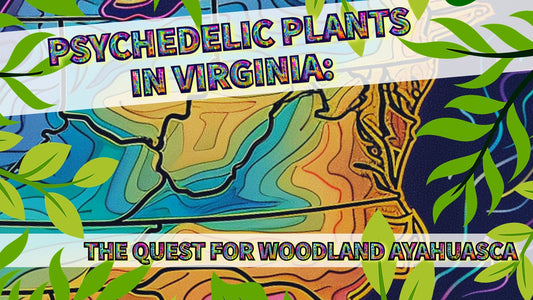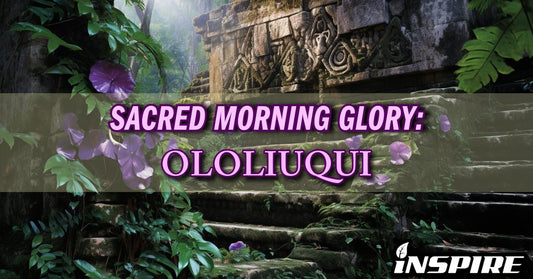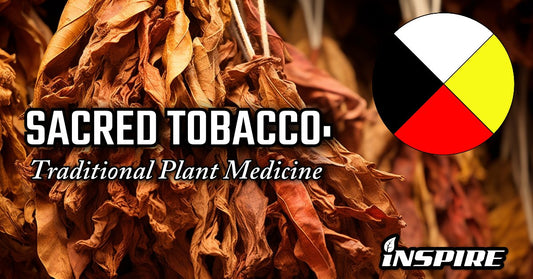Written By: Zach Champ
Connect with me on Instagram!
**Based on information and research compiled from the Internet

WHAT IS AYAHUASCA?
Ayahuasca is a powerful entheogenic brew traditionally used by indigenous communities in the Amazon rainforest.

The brew typically consists of two main ingredients: the Banisteriopsis caapi vine, which contains MAO inhibitors, and the leaves of the Psychotria viridis or Diplopterys cabrerana plants, which contain the psychoactive compound DMT.
It's important to note that the traditional Ayahuasca recipe and its effects are specific to the indigenous Amazonian cultures and their rituals.

WHY AYAHUASCA & PSYCHEDELIC PLANTS?
Ayahuasca and psychedelic plants have gained popularity in recent years for several reasons:

-
Spiritual and Therapeutic Benefits: Many individuals seek Ayahuasca for its potential spiritual and therapeutic benefits. Traditional users in Amazonian indigenous cultures consider Ayahuasca as a sacred medicine that allows them to connect with the spiritual realm, gain insights, and receive guidance. Some participants report profound and transformative experiences, leading to increased interest in exploring Ayahuasca for personal growth and healing.

-
Healing and Mental Health: Ayahuasca has garnered attention for its potential in treating various mental health conditions, such as depression, anxiety, PTSD, and addiction. Some research suggests that the psychedelic experience induced by Ayahuasca may lead to enhanced self-awareness, emotional processing, and neural changes that could positively impact mental health.

-
Increasing Interest in Psychedelic Research: As the field of psychedelic research expands, Ayahuasca has become a subject of scientific investigation. Researchers are studying its effects on the brain, consciousness, and mental health, contributing to a growing body of evidence supporting its potential therapeutic applications.
-
Media and Publicity: Ayahuasca has received substantial media coverage in documentaries, books, and news articles. These portrayals have increased public awareness and piqued curiosity about the brew and its effects.

-
Seekers of Alternative Experiences: Many individuals are curious about exploring altered states of consciousness and non-ordinary experiences. Ayahuasca offers a unique and profound journey, making it appealing to those seeking alternative perspectives on reality and spirituality.

-
Increased Accessibility: Ayahuasca retreats and ceremonies have become more accessible in various parts of the world, not just in the Amazon region. This accessibility has made it possible for people from diverse backgrounds and cultures to participate in Ayahuasca ceremonies.

-
Internet and Social Media: The internet and social media platforms have played a significant role in disseminating information about Ayahuasca. People can easily find personal testimonies, research, and resources related to Ayahuasca use and its effects.

-
Integration and Wellbeing: The concept of "integration" has become more prominent in the psychedelic community. Integration refers to the process of making sense of and applying insights gained from psychedelic experiences to daily life. Many people view Ayahuasca as a tool for self-discovery and personal growth, emphasizing the importance of integration into their lives.

DO ANY PLANTS IN VIRGINIA CONTAIN DMT?
In Virginia, there are no known native plants that contain significant amounts of N,N-Dimethyltryptamine (DMT).
DMT is the primary psychoactive compound found in plants used for Ayahuasca preparations. DMT is typically sourced from plants native to regions such as the Amazon rainforest in South America.

Virginia, located in the eastern United States, does not naturally host the specific plants typically used in traditional Ayahuasca preparations. Banisteriopsis caapi, also known as the Ayahuasca vine, is native to South America, while Psychotria viridis and Diplopterys cabrerana are native to the Amazon rainforest.
Despite this there are reports of some common landscape plants found in Virginia containing trace amounts of DMT.

For example, various species of Phalaris grass, including Phalaris arundinacea (reed canary grass) and Phalaris aquatica (harding grass), have been reported to contain small quantities of DMT.
It's important to note that the concentration of DMT in these plants is typically very low, and the preparation and extraction of DMT from these sources can be challenging and potentially dangerous.

While it's technically possible to extract trace amounts of DMT from certain plants found in Virginia, it is essential to approach such practices responsibly and legally. The extraction and use of DMT, even from plant sources, may be subject to legal restrictions in many jurisdictions.
However, if you are interested in exploring plant-based entheogenic experiences within the region, Virginia does have its own native plants with potential psychoactive properties!

PSYCHOACTIVE PLANTS IN VIRGINIA
Psychoactive vs Psychedelic
Psychoactive drugs encompass a broad category of chemical substances that interact with the nervous system, leading to alterations in perception, mood, cognition, and behavior.
These substances can range from prescription medications to recreational drugs and even naturally occurring compounds found in plants.
On the other hand, psychedelic drugs represent a specific subset of psychoactive substances characterized by their serotonergic hallucinogenic properties.

Psychedelics induce profound alterations in consciousness, affecting all senses and significantly modifying an individual's thinking, sense of time, and emotional experience.
While psychedelics primarily refer to serotonergic hallucinogens, the term can also encompass other categories of drugs such as dissociatives, empathogens-entactogens, and atypical hallucinogens.

The distinction between psychoactive and psychedelic drugs lies in the intensity and nature of the effects they produce. While all psychedelics are psychoactive, not all psychoactive substances are considered psychedelics.
Additionally, psychedelics hold unique potential for inducing transformative experiences, often characterized by profound insights, spiritual revelations, and mystical encounters.
Entourage Effect
The key to creating a truly entheogenic and psychedelic visionary experience utilizing native plants relies on understanding the principles of the “Entourage Effect”.

This principle highlights the synergistic interaction between various chemical constituents within plants or combinations of plants, which collectively produce enhanced therapeutic or psychoactive effects compared to isolated compounds.
By harnessing the synergistic benefits of multiple compounds within a plant, practitioners aim to create holistic and profound visionary experiences that honor the plant's inherent wisdom and healing potential.

AMERICAN SPIKENARD
One example of a native Virginia plant with potential psychoactive properties is the American Spikenard (Aralia racemosa).
American Spikenard, also known as Indian root or life-of-man, is a native perennial herb found in wooded areas of eastern North America. It is a woody flowering plant with a thick, tuberous rhizome containing a distinctive yellow latex.

American Spikenard belongs to the Ginseng and Wild Sarsaparilla family of plants. It's found in the moist forests of the Appalachian Mountains and has a mild, anise-like scent.
It has been historically used by Native American tribes for various medicinal purposes, such as treating respiratory issues, digestive problems, and rheumatism. It is also used to loosen chest congestion, boost tissue regrowth, and promote sweating. Some people apply American spikenard directly to the skin as an alternative to sarsaparilla for treating skin diseases.
Some tribes, such as the Iroquois and the Menominee, have also used it as a ceremonial plant.

A 2016 chemical analysis of American spikenard leaves found that they contain the following active constituents: Flavonoids, Phenols, Saponins, Terpenoids, Glycosides.
While there are reports of spiritual experiences associated with American Spikenard, more scientific research is needed to understand its chemical composition and potential psychoactive properties.

BLOODROOT
Bloodroot (Sanguinaria canadensis) is a perennial flowering plant native to eastern North America, including regions like Virginia.
Known for its blood-red sap, bloodroot holds a storied history of traditional use among Native American tribes, who utilized it for a variety of purposes, including treating skin conditions, respiratory issues, and even as a dye for clothing and baskets.

Historically, it was widely used by Native Americans in blood tonification and purification, pain and fever relief, and wound healing. Native Americans also revered Bloodroot as a herbal remedy for love and vitality, utilizing it as a form of sexual medicine to enhance intimacy and romantic connections.
Bloodroot has also garnered attention for its potential narcotic properties. While it is not classified as a traditional narcotic drug, certain compounds found within Bloodroot, such as sanguinarine, possess psychoactive properties that may induce narcotic-like effects when consumed in large quantities.

SANGUARINE

COPTISINE
Central to bloodroot's medicinal efficacy are its diverse array of bioactive compounds, including sanguinarine, berberine, coptisine, narceine, and protopine.
These constituents harbor a wealth of therapeutic potential, with coptisine exhibiting antidepressant properties by inhibiting Monoamine Oxidase A (MAO-A), and narceine acting on central nervous system receptors to induce pain relief and trigger the release of histamines.

In modern herbalism, bloodroot is often prepared as a tincture, decoction, or topical ointment, with its underground stem, or rhizome, serving as a potent reservoir of medicinal compounds. These preparations are used to address a wide range of health concerns, including skin irritations, respiratory ailments, and even as an adjunct therapy for certain chronic conditions.
While these compounds offer promising therapeutic benefits, caution must be exercised, as products containing high concentrations of bloodroot can lead to adverse effects such as tissue destruction, scarification, and keloid formation when applied topically. Therefore, it is essential to approach the use of bloodroot with care and seek guidance from qualified healthcare professionals.

DATURA / JIMSON WEED
Datura (Datura wrightii), also known as "Jimson Weed" or "Thorn Apple," is a mesmerizing plant found throughout Virginia.
A member of the Nightshade family, which includes tobacco and tomatoes, Datura possesses trumpet-shaped flowers that bloom only at night, emitting a captivating fragrance.

However, its beauty conceals a deadly secret, as it is highly poisonous and contains Tropane Alkaloids, including scopolamine, known to induce delirium, hallucinations, and confusion.
Throughout history, Datura has been associated with mind control, inebriation, and even featured in medieval "Witches Flying Ointments." Its perilous allure is also tied to Haitian Voodoo's belief in its ability to induce a "zombie" state.
Caution is vital when encountering Datura, as its effects are unpredictable and hazardous, making its use discouraged even among seasoned herbalists and shamans.

READ MORE ABOUT DATURA IN OUR BLOG HERE

GHOST PIPE
Ghost Pipe (Monotropa uniflora), found in every county in Virginia, is a native wildflower thriving in the deep, shady woods of low to moderate elevations.
Its ethereal presence graces the forest floors across much of the United States, from Maine to California and from Florida to Alaska, yet eludes the southwest, intermountain west, and the central Rocky Mountains.

A botanical enigma, Ghost Pipe lacks chlorophyll, deriving sustenance instead by sapping nutrients from nearby tree roots through mycorrhizal fungi. This unique adaptation allows it to flourish in the dim recesses of the forest where other plants struggle to survive.
Ghost Pipe taps its roots into the place where the mycelium meets the rhizome, drawing off nutrients from both the host tree and the mycellium. Tapped into these nodes in the mycorrhizal network, Ghost Pipe is tapped into two very different systems for processing information – essentially two very different forms of consciousness.

There is the Mycelial awareness, diffuse and expansive, traversing vast networks of nerve-like filaments, and exchanging information in a rapid, multidirectional dance at all times…

Likewise, there is the ancient consciousness of trees (which in stark contrast) harbor a deep, temporal wisdom within their rings, almost like etching information into stone, that communicates knowledge about the tree and its environment through the memories of rain, drought, and fire.

As it draws nutrients from the mycorrhizal web, Ghost Pipe also absorbs the information exchanged between trees and the fungal mycelllium network that covers the entirety of the forest floor’s surface, serving as a conduit for the forest's collective wisdom.
The medicinal properties of Ghost Pipe extend beyond its physical attributes, offering a unique ally in modulating sensory input for humans. Resembling a spine and brainstem, this plant has been utilized as an anxiolytic in herbal medicine since the late 19th century. Its dried stalks can be brewed into a mildly sedative tea or smoked, providing a gentle means of calming the mind and body. This soothing effect may be attributed in part to the presence of salicylic acid within the plant.

The Ghost Pipe is part of many native creation stories and myths. The Cherokee traditionally have a story that describes why the plant is called “Indian Pipe”.
Legend holds that there once was a group of Chiefs arguing over something trivial. The argument was so heated that it resulted in conflict. When the chiefs finally came to smoke a peace pipe to resolve their conflict, the Great Spirit transformed the quarreling chiefs into the plant, serving as a poignant reminder of the importance of reconciliation and peace.
Natives believe that Ghost Pipe emerges wherever friends have clashed,, a symbol of healing and forgiveness in the natural world.

MORNING GLORY
Morning Glory (Ipomoea spp.) is a hardy, annual vine renowned for its resilience and adaptability, capable of thriving in diverse environmental conditions.

Also known by its indigenous names such as "Snake Plant" or Ololiuqui, this botanical marvel traces its origins to the lush landscapes of Mexico, Central America, and the American Southeast.
Morning Glory's seeds contain the psychoactive substances lysergic acid amide (LSA) as well as ergot-based alkaloids. These compounds, reminiscent of those found in LSD, elicit profound effects on perception, cognition, and consciousness.
When consumed, Morning Glory seeds can induce hallucinations, euphoria, and introspective experiences, akin to the effects of LSD.
LEARN MORE ABOUT MORNING GLORIES IN OUR BLOG HERE

SASSAFRAS
Sassafras (Sassafras albidum) is a deciduous tree native to eastern North America, including regions like Virginia.
Historically, various parts of the sassafras tree, including the roots, bark, leaves, and fruits, have been used by indigenous peoples and early European settlers for medicinal, culinary, and aromatic purposes.

One of the notable features of sassafras is its aromatic properties, particularly in its roots, which contain safrole, a volatile oil responsible for its characteristic scent.
Safrole is a clear, colorless, or slightly yellow liquid with a root-beer like odor. It's used as a flavoring agent in drugs, beverages, and foods, and to make other chemicals.

Safrole has been classified as a potential carcinogen by regulatory agencies, and its use as a flavoring agent or food additive has been restricted or prohibited in many countries, including the United States.
Safrole serves as a key precursor in the underground production of MDMA (3,4-methylenedioxymethamphetamine) and MDA (3,4-methylenedioxyamphetamine), two psychoactive substances known for their euphoric and empathogenic effects.

In illicit drug synthesis, safrole extracted from Sassafras is utilized to produce MDP2P (3,4-methylenedioxyphenyl-2-propanone), a crucial intermediate compound in the manufacturing process of MDMA. Through a series of chemical reactions, MDP2P is transformed into MDMA, the main active ingredient in the street drug commonly referred to as ecstasy or “molly”.

Furthermore, an intriguing aspect of safrole lies in its potential to undergo biosynthesis within the human body.
Safrole can be metabolized into MDMA and serotonin, a neurotransmitter associated with mood regulation and emotional well-being.
This metabolic conversion underscores the complex interplay between plant-derived compounds and physiological processes, highlighting the intricate relationship between natural substances and human biology.

Besides its aromatic properties, sassafras has been associated with traditional medicinal uses, including as a remedy for various ailments such as fevers, skin conditions, and rheumatism. However, the psychoactive properties of sassafras are not well-documented or widely recognized.
Native American medicine practices understood that Sassafras, when brewed in a special tea with other herbs, could create an entheogenic and empathogenic brew. Scientists are now conducting experiments based on ethnobotanical recipes and are discovering new novel ways of synthesizing MDMA using traditional techniques and methods.

SKULLCAP
Skullcap (Scutellaria lateriflora) also known as “Mad Dog Skullcap” or “Blue Skullcap” is a flowering herbaceous plant native to North America, commonly found in moist wetland habitats such as marshes, meadows, and riverbanks.

While skullcap is primarily known for its nervine and sedative properties, it is not typically considered to be a strong psychoactive plant in the same sense as other hallucinogenic or entheogenic plants. Instead, skullcap is valued for its ability to promote relaxation, ease tension, and support nervous system health. It is often used as a mild sedative to help alleviate symptoms of anxiety, insomnia, and nervousness.
Rich in bioactive compounds such as flavonoids—including baicalin and baicalein—skullcap boasts a diverse pharmacological profile. These constituents contribute to its medicinal efficacy, offering potential anti-anxiety, anti-inflammatory, and neuroprotective benefits.

SCUTELLARIN
Furthermore, skullcap contains serotonin, melatonin, and scutellarin, adding to its therapeutic arsenal.
When used in herbal preparations, skullcap is typically consumed as a tea, tincture, or capsule as a mild sedative and sleep promoter. It is generally considered safe when used in appropriate doses.
In the past, Scutellaria lateriflora was embraced as a common treatment for conditions such as hysteria and hydrophobia induced by rabies.

PASSIONFLOWER
Passionflower (Passiflora incarnata) is a beautiful and intriguing plant known for its calming and sedative effects. While it is not considered a powerful psychedelic like Ayahuasca or Psilocybin mushrooms, it does have some mild psychoactive properties, which have been utilized for centuries by various indigenous cultures for medicinal and spiritual purposes.

Passionflower has a long history of traditional use by various indigenous cultures in the Americas. Native to North America and Central America, it has been used by Native American tribes for its medicinal and spiritual properties. The Passiflora genus contains over 500 species, with several of them having cultural and medicinal significance.
The Cherokee and other Native American tribes used passionflower as a sedative, anxiolytic, and analgesic, often employing it as a herbal remedy for relieving pain, anxiety, and sleep disturbances. Some tribes also used it in rituals and ceremonies to induce altered states of consciousness and for dream enhancement.

During the colonial period, Passionflower's introduction to Europe led to its adoption in Western herbal medicine. Its reputation as a calming and sleep-inducing herb spread, and it was used as a remedy for restlessness and nervousness.
In the present day, Passionflower continues to be widely used as a natural remedy for anxiety, insomnia, and stress. It is available in various forms, including teas, tinctures, capsules, and extracts.
While it is not considered a mainstream psychedelic, its relaxing and calming effects contribute to its popularity in the herbal medicine and wellness communities.
Passionflower contains a variety of alkaloids that contribute to its overall chemical composition including:

- Harmine: Harmine is a beta-carboline alkaloid that is also found in plants like Banisteriopsis caapi, which is used in Ayahuasca preparations. Harmine is a monoamine oxidase inhibitor (MAOI) and has been associated with potential antidepressant and anxiolytic effects.

- Harmane: Harmane, is found in Passionflower. Harmane has been implicated in various biological activities and has been investigated for its potential neuroprotective and antidepressant effects.

- Harmaline: Harmaline is structurally similar to harmine and has been associated with various psychoactive effects. Harmaline is known for its MAOI properties and has been used in other plants for traditional and ceremonial practices in other cultures including the Amazon.
TOBACCO
Tobacco (Nicotiana tabacum) is a plant known for its psychoactive properties, primarily due to its main active alkaloid, nicotine.

Tobacco is native to the Americas and has a long history of use by indigenous peoples in the region. It is believed that tobacco has been cultivated and used for over 2,000 years. Native American tribes were among the earliest users of tobacco, and they considered it a sacred plant with both medicinal and spiritual significance.
Various Native American tribes incorporated tobacco into their rituals and ceremonies. For some, tobacco was used as an offering to the spirits, while others believed that the smoke from tobacco could carry their prayers and intentions to the heavens. The ceremonial use of tobacco varied between tribes and often played an essential role in their cultural and spiritual practices.

With European colonization and global trade, tobacco spread to other parts of the world. It quickly gained popularity in Europe and became a major cash crop in many countries.
The widespread use of tobacco led to its incorporation into various cultures and traditions, with different methods of consumption and social significance emerging over time.

While tobacco has been an essential part of cultural and spiritual practices for many indigenous peoples, its recreational and addictive use has also led to significant health concerns and social issues, including tobacco-related illnesses and addiction.
In contemporary times, tobacco remains one of the most widely used psychoactive substances worldwide. However, it is essential to recognize and address the health risks associated with tobacco use, particularly smoking, which is a major cause of preventable diseases and premature death. Public health efforts focus on reducing tobacco use and promoting healthier alternatives.
LEARN MORE ABOUT TOBACCO BY READING OUR BLOG HERE

CAUTION AND CONSIDERATION:
It's important to approach the use of these plants with caution and respect. Engaging in any form of entheogenic plant use should be done responsibly, respecting legal and cultural considerations.

It is crucial to thoroughly research the plants, their potential risks, and the legal implications associated with their use.
Seeking guidance from experienced individuals or indigenous cultures with knowledge of entheogenic plant use is highly recommended.
REFERENCES & RESOURCES:
-
Hallucinogens by US Forest Service
-
Poisonous Plants in Virginia by The Socrates Project (University of Virginia)
-
Hallucinogenic Plants: A Golden Guide by Richard Evan Schultes
-
Ghost Pipe: A Little Known Nervine by Sean Donahue (American Herbalist Guild)
-
Medicinal Herbs of Central Illinois by James E Hefley (Eastern Illinois University) **American Spikenard











